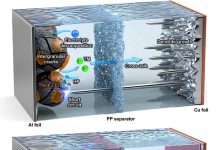
Scientists at the University of Limerick (UL) in Ireland have developed a groundbreaking new battery that could transform electric vehicles, portable devices, and renewable energy storage.
The team has built the world’s first full-cell dual-cation battery, which uses both lithium and sodium ions to boost performance and stability—marking a major step forward in sustainable energy technology.
The research, published in Nano Energy, was led by Associate Professor Hugh Geaney and Dr. Syed Abdul Ahad, a Government of Ireland postdoctoral fellow at UL’s Bernal Institute.
Their work, in collaboration with the University of Birmingham, could help create batteries that are more powerful, affordable, and environmentally friendly.
Today’s batteries mostly rely on lithium ions, which deliver high energy but come with environmental and supply chain concerns.
Sodium-ion batteries, on the other hand, use more abundant and cheaper materials but generally store less energy. The new UL battery combines the strengths of both elements in a single system.
“For the first time, we’ve shown that sodium-ion batteries can be ‘supercharged’ by pairing sodium and lithium in a sodium-dominant dual-cation electrolyte,” said Geaney. “This breakthrough opens the door to more sustainable, high-performance battery chemistries.”
Dr. Ahad, who designed and led the experiments, explained how the concept works: “By introducing both lithium and sodium cations, we effectively double the battery’s capacity compared to a typical sodium-ion battery.
Lithium acts as a capacity booster while sodium remains the main working element. This approach has never been demonstrated before using the materials we tested.”
The new design allows lithium ions to enhance the energy density of the sodium-based system, giving it the power of a lithium battery without relying heavily on lithium itself. The result is a safer, more stable, and more eco-friendly battery that can run for up to 1,000 charge-discharge cycles—a key requirement for electric vehicles and grid-scale storage.
Besides improving performance, the dual-cation system helps reduce dependence on rare and expensive metals like cobalt, which are often mined under environmentally harmful conditions. “Our work provides a realistic path toward greener and more sustainable batteries,” said Geaney.
The researchers are now exploring new material combinations and other ion pairings, such as lithium-magnesium and potassium-lithium, to push the technology even further. They are also testing silicon-based anodes that could further enhance capacity.
If successful, this Irish-led innovation could usher in a new generation of sustainable batteries—ones that charge faster, last longer, and help power a cleaner world.



